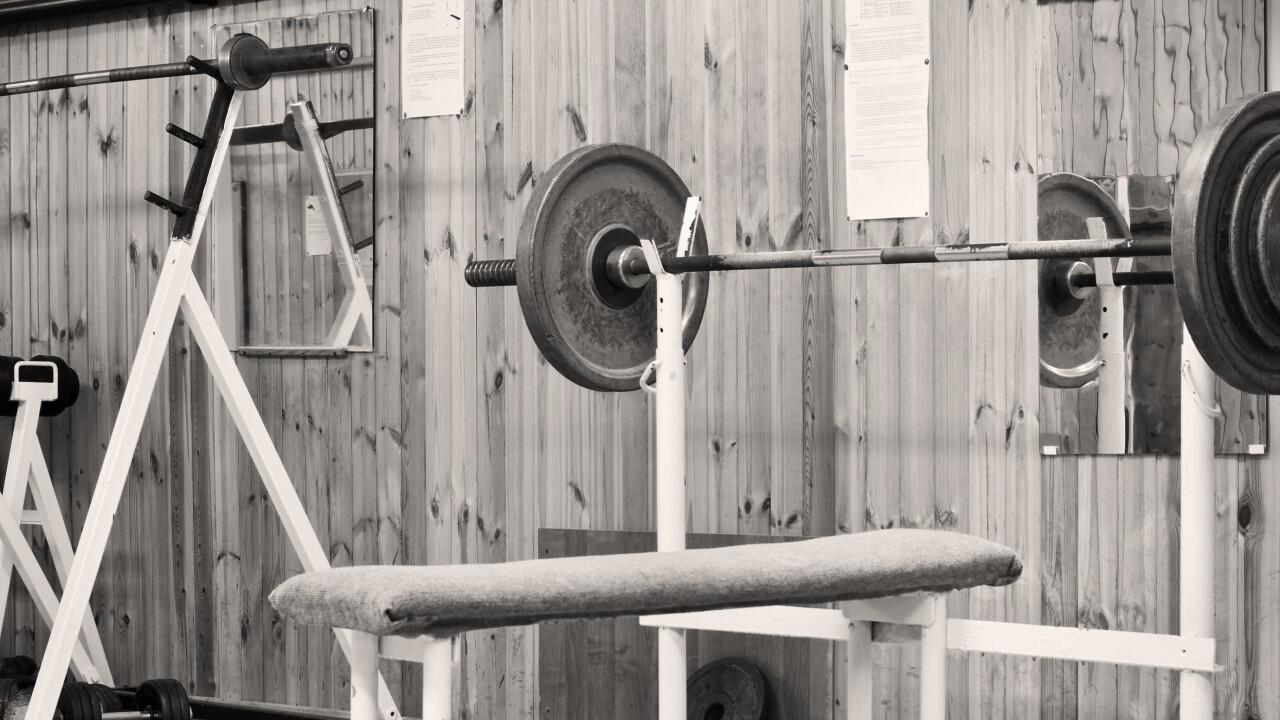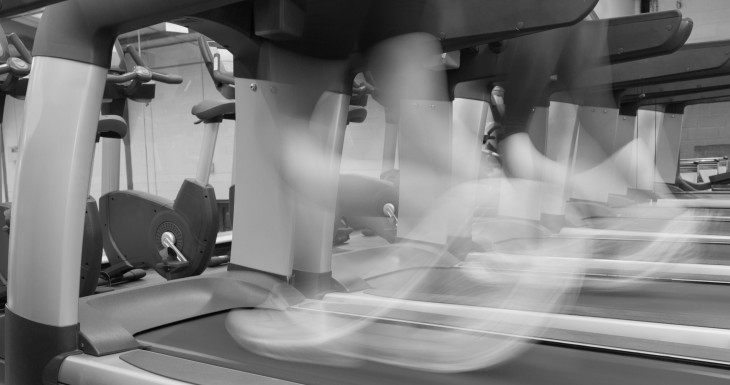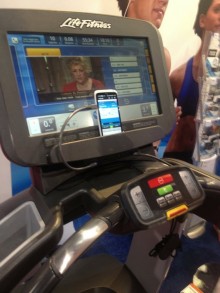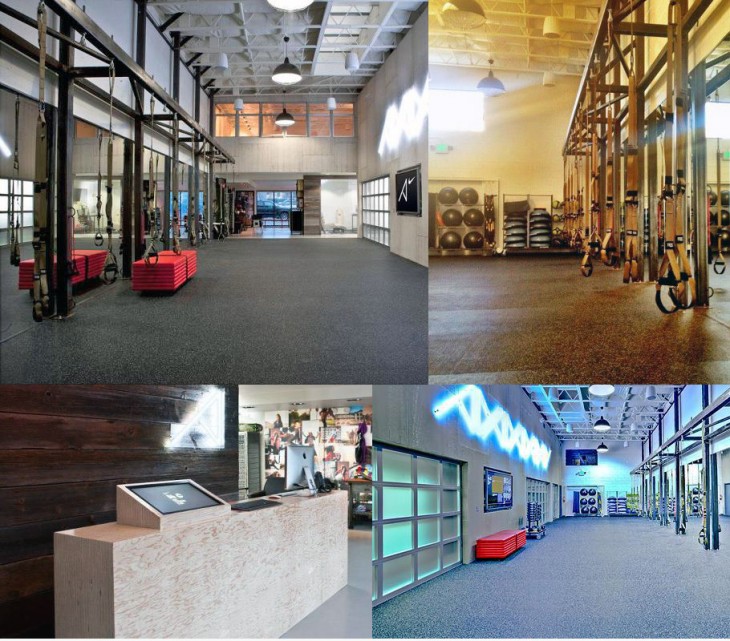
This is the fourth in our Future Of series, where we analyze and dissect one facet of life that’s been impacted by digital technology. Today, we look at gyms.
“Gyms need to incorporate newer technology and communicate how this will benefit its members.”
If you thought gyms were a recent phenomenon, tethered to the trend of self-conscious fashionistas and the scourge of obesity, well, you’d be wrong. Gymnasiums, or ‘gymnasia’, go back thousands of years to Ancient Greece where you’d find dedicated exercise auditoriums typically consisting of spacious training grounds for athletic contests.
The first modern-era gyms – that is, public equipment-filled rooms of the ilk you would recognize today – started to crop up around the middle of the 20th century. But it wasn’t until the 1960s when William Staub developed the first successful consumer treadmill that things really started to accelerate, with keep-fit freaks no longer reliant on good weather and daylight to attain that sub-6-minute mile.
We thought we’d take a look to see what the current state of play is with gyms, and whether we’re on the cusp of a technological revolution.
Business is booming

Today, health and fitness is a massively profitable industry, and much of this comes down to gyms and health clubs. According to recent figures from the International Health, Racquet & Sportsclub Association (IHRSA), US health club industry revenue reached $21.8 billion in 2012, up from $20.3 billion in 2010.
Indeed, more than 58 million Americans used a health club in 2012, with 50.2 million of those signed-up members of a fitness center or gym, representing a rise of 10% since 2008. Around 17% of the US population have put pen to paper to attend a health club regularly.
Granted, not all these people will be pumping iron or pushing themselves to the physical limit – some may be lounging in pools or slouching in saunas. But it’s still indicative of how much people are willing to invest in their physical health, even though there are perfectly good free alternatives.
It’s not just the US – the desire to stay fit and healthy is an international phenomenon. The IHRSA Global Report reveals that the health club industry generated around $75.7 billion from more than 153,000 clubs around the world, serving 131.7 million members. Jay Ablondi, IHRSA’s executive vice president of global products, says:
“The global health club industry continues to expand, thanks to strong growth in Latin America, Germany, and China, coupled with solid performance in the US – which is home to more health clubs than any other single country. Worldwide, consumers are demonstrating an increased demand for health club services and club operators are responding with conveniently located facilities and a wide range of amenities.”
Specific to Europe, 44 million people claim health club memberships across 48,000 clubs, helping to generate €25 billion in revenue. Sure, the economic downturn has impacted some markets, given that gym memberships are clearly among the most dispensable expenses in times of financial trouble, but the industry still grew across a number of countries, including Germany, Norway, Poland, Russia, and Sweden.
Diversification has played a role too in uptake, with female-oriented gyms and smaller ’boutique’ gyms tapping different demographics.
It seems that gyms and fitness clubs are thriving, but with digital technologies such as smartphones and home-consoles getting increasingly sophisticated, we set out to discover what the future may hold for gyms.
Home is where the health is
Gym equipment has been widely available and affordable for years, but this notion of a ‘home gym’ hasn’t really taken off in a big way; not compared to public gyms, at least. But we’re certainly seeing a greater push in that direction, with more choices than ever tempting people away from their local Fitness First, and onto their living room rug.
Last October, Nike partnered with Microsoft for Nike+ Kinect Training, featuring customizable fitness regimes using the motion-sensing miracle that is Kinect.
It assesses your basic level of fitness – a few squats and lunges are enough to tell the system how strong you are on each side, with Kinect detecting any shakes or wobbles along the way. It then constructs a program for you accordingly, involving burpees, lunges and a bunch of other exercises (probably ending in ‘es’) that you may or may not have heard of before.

It also connects up with your Nike+ FuelBand, and lets you compete with friends virtually. This all sounds great but, of course, it does rely on the user being proactive enough to actually use this on a regular basis, which is the age-old problem with any home gym set-up – irrespective of how advanced it is.
For many, there is simply no replacing the interactivity and engagement that comes with a fully-fledged gym membership.
For those happy to use the natural environment as their gym, there’s no shortage of GPS fitness-tracking apps, waterproof gadgets and dedicated health trackers to quantify one’s every movement, record it for posterity and get a massive one-up on your local fitness club.
Runtastic is one such service, that taps the GPS on your pocket rocket to measure distance, pace, elevation and speed, saving it all to the cloud so you can look back at your achievements and see where you’ve improved and where there’s room for improvement.
Last year, Runtastic broke from its outdoor roots and launched four brand-new apps aimed squarely at homebodies, covering situps, pushups, pullups and squats. And as of last week, the company’s branching out specifically into six-packs, with a new app dedicated to helping you attain a torso like a washboard.
Then there’s BitGym, a Kickstarter-funded project that uses Google Street View Hyperlapse videos and motion-tracking to bring stunning surroundings including trails and paths to your treadmill and exercise bike workouts. The mobile apps are due to launch later this year, and should prove popular with gyms-goers and homebodies alike.
http://www.youtube.com/watch?v=DMRU_IOEJm4
So there’s clearly a demand for recreating the great outdoors inside, but sticking specifically to the theme of home gyms, what exactly is the appeal? We spoke with Runtastic founder Florian Gschwandtner to get his thoughts on why home workouts appeal to some people.
“Not everybody has the time to go to the gym,” says Florian. “When you consider the time it takes to get to the gym, get ready, do the workout and everything else around it, you could be looking at over one-and-a-half hours. With apps and home workouts, you can do a whole session in 20 to 30 minutes. This is also great for motivation, as it’s easier for many people to do a 20 minute workout compared to dealing with the gym and associated time.”
If you happen to live next door to a state-of-the-art gym, this may not apply to you. But if you’re even twenty minutes from a fitness center, that’s a forty minute round-trip right there. And then there’s using the locker-room, showering and everything in between. If you choose to work out at home, or even run a circuit from your house, you don’t have to worry about packing bags or waiting for the bus.
Reading all this, you could be forgiven for thinking that gym-owners would be sweating at this onslaught of new-tech that makes it easier and cheaper to keep-fit without forking out $50+ a month. But they most certainly aren’t panicking yet.
Motivation is obviously one facet – people can’t be trusted to adhere to their own regime at home and, by paying for a service, this gives them the much-needed oomph to get off their sofa and do some exercise. Granted, it also means many people squander their hard-earned money by never using their membership, but that’s an argument for another day.
But over and above motivation, there is an intrinsic human desire to be social. This is just as we concluded when we looked at the continued popularity of cinemas, in that people like being with other people. We wrote:
“There is often an assumption that technology is somehow transforming everyone into antisocial hermits, but I really don’t think that’s the case…In the end, everyone has an insatiable urge to meet up with other humans – friends, parents, sisters, brothers, work colleagues – and do things together. And on any given afternoon or evening, they can go drinking, clubbing, jogging, bowling or, indeed, to the cinema.”
The gym is what you make of it. You can be in a class with 25 other sweaty people, spinning along to some cheesy Euro-pop music. Or you could have your head down on a running machine as you try to beat your personal 5km best. Regardless of whether you talk to people or not, you’re still with them, and that’s a harder experience to replicate at home or out in the park without having to round-up some friends at the last minute.
It’s worth mentioning here that the latter of these experiences is actually being boosted for keep-fit fanatics, not by technology, but by outdoor initiatives such as Military Fitness, which replicates the social experience of a gym in your local park. But this of course won’t be for everyone – it can be muddy, cold, wet and often very miserable. It’s not for the faint-hearted when winter comes calling.
“I really love going to the gym – usually I go four to give times a week,” says Florian. “But I always do fast workouts. Gyms are very important because they are a lifestyle statement to be there and see other people working out. I also think gyms need to incorporate newer technology and communicate how this will benefit its members. I’d really like to see more statistics, for example how often I’ve been to the gym in a month, how much time I spent doing what, and so on.”
It’s evident that digital technology offers more choices than ever for those looking to side-step pricey gym memberships and do their own thing. But as we’ve seen, gyms are positively booming, and they certainly won’t be going the way of the dodo any time soon.
With that in mind, it’s worth taking a peek to see what the future may hold for your local health club. And part of that involves looking at what’s going on now.
A lens into the future
Perhaps one of the biggest mistakes here would be to assume that gyms and home or outdoor workouts are mutually exclusive. They’re not.
You may have a gym membership for winter or evening training, or for tapping access to personal trainers and specialized equipment. But equally, you may love nothing more than a 60 mile weekend cycle or 20 mile summer jog out in the country – many people enjoy the best of both worlds. And this is a key point – gyms must open up to the innovations going on in the digital realm. An app such as Runtastic will let you manually enter a run or cycle that you do in the gym, but there’s generally no easy way of automating this so that your treadmill sprint is added to your Runtastic profile as soon as you hit that ‘stop’ button.
 We are starting to see some moves in this direction though. At CES in January, Runtastic and American fitness equipment manufacturer Life Fitness announced a partnership that would see its treadmills integrate with the Runtastic app so that a user’s session data is saved to their Runtastic profile. But there’s a long way to go though before this becomes standard.
We are starting to see some moves in this direction though. At CES in January, Runtastic and American fitness equipment manufacturer Life Fitness announced a partnership that would see its treadmills integrate with the Runtastic app so that a user’s session data is saved to their Runtastic profile. But there’s a long way to go though before this becomes standard.
“Here, I see a bit of a ‘chicken and egg’ challenge – we have spent a lot of time on this question and there has to be a solution,” says Runtastic’s Florian.
“Unfortunately, not all gyms are changing their equipment every year, and it will take a long time for those new treadmills to be rolled out,” he continues. “We also thought about working with QR codes or NFC, but there is a lot of different gym equipment in the market.”
It seems that the myriad of manufacturers and brands makes it difficult to find a solution, as it would require a lot of different parties working in concert to make it happen quickly.
It’s worth looking at Technogym too, a company that’s setting out its stall to bridge this fitness duality.
Technogym recently introduced its Wellness on the Go initiative, which promises a personalised fitness experience that lets users access their training program, data, bookmarks, apps and content on Technogym equipment. A user can log-in and access their training program through their mobile device, a dedicated ‘mywellness key’, smart TV or PC. To complement this, it launched its ARTIS range of equipment, which it refers to as “the gym of the future”.
Each ARTIS machine has an interactive console for users to tap their programs and history. And they’re also fitted with a Web cam, letting users make video calls with their trainer or, indeed, anyone they wish.
Similar to Life Fitness and Runtastic, Technogym partnered with RunKeeper earlier this year, letting users of ARTIS equipment sync their gym and GPS-based workouts. Moreover, MapMyFitness is a partner too, while Nike and Apple are working with Technogym, with a view towards making its cardio equipment Nike+ iPod compatible.
Anytime Fitness, a chain with more than 2,000 fitness clubs around the world, is edging towards becoming a ‘Netflix for gyms‘ with its online Anytime Health platform, which is designed to help members track their progress and connect with other users.
Elsewhere, Precor has Preva, Matrix has M-Power, and Free Motion has iFit. This is all a step in the right direction, but given the costs for gyms to replace and upgrade machines, it could still be some time before such setups become the norm.
It’s clear that connectivity and cloud are creeping into gyms around the world, but what else can we expect to see from the gyms of the future? Well, Alpha Venice in California is a good starting point.
Automated gyms

Fitness trainer Joselynne Boschen teamed up with Nike to open a fitness center specifically for Nike Training Club (NTC) classes. Members can use the so-called ‘open gym’ in conjunction with the NTC app on their own mobile devices. And if they don’t own such new-fangled gadget, well, they can rent an iPod touch from the front desk.
In terms of checking in you simply scan your finger, and if you want to purchase anything you scan the associated QR code with your device. The NTC training app can also be beamed to a 70-inch LCD touchscreen during classes, while a digital jukebox on the TV lets members create playlists in advance.
Alpha Venice helps to illustrate how gyms may look to automate as much as possible, which will have huge ramifications for cost-savings in terms of personnel too.
My Time Fitness in Chicago is following a similar model, a 24-hour gym with fingerprint access and cameras monitoring the premises rather than humans. Though there is a small minimum monthly charge, it broadly follows a pay-as-you-go model, similar to something like Zipcar. But it also offers standard memberships for those willing to sign-up for the long haul.
It’s worth dwelling on this final point. Gyms are notorious for their contract-based lock-ins, which put many people off signing up. Sure, you can sometimes pay for a day’s access, but that is often prohibitively expensive to encourage people to sign on the dotted line. Why should that be the norm though? Why shouldn’t your local gym offer a credit-based swipe card that just charges you each time you visit?
There’s definitely scope at least for a two-tier system within gyms, whereby users can be incentivized to sign-up for longer through slightly cheaper rates, but those who can’t commit to going regularly aren’t charged through the nose as a result.
Runtastic’s Florian doesn’t necessarily follow this train of thought though.
“I don’t think prices have to come down, but I’m definitely sure that technology will be very important for gyms in future,” he says.
“Imagine you are doing bicep curls and you can immediately see on your phone, how many reps you did the last time? if you did more than last time, you could earn a badge, record, or discount on a product sold there. That would be amazing, and from a technical perspective, this is already doable. I believe it’s just a matter of time. We’re in contact with some manufacturers, so we do know that they’re thinking about it, but nobody wants to do this the wrong way, and they’re just starting to figure out what the right way could be.”
The gym of the future: connected, automated and contract-free?
Image Credits
Feature Image – Shutterstock | Image 1 Shutterstock
Get the TNW newsletter
Get the most important tech news in your inbox each week.




